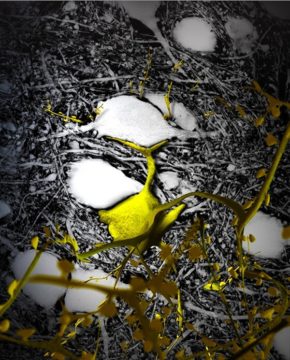2 ERC Synergy Grant projects involving FBI Members
Congratulations to Emmanuel Beaurepaire (CNRS Research Director from the Laboratory for Optics and Biosciences CNRS-INSERM-Polytechnique), PI of the ERC Synergy Grant project “HOPE”, and to Laurent Groc (CNRS Research Director ; Interdisciplinary Institute for Neuroscience), coordinator of the ERC Synergy Grant project “ENSEMBLE“, Laurent Cognet (CNRS Research Director ; Laboratoire photonique numérique et nanosciences) and U. Valentin Nägerl (Professor at University of Bordeaux ; CNRS Research Director ; Interdisciplinary Institute for Neuroscience), both PIs of the ERC Synergy Grant project “ENSEMBLE“.
These grants, each worth around 10 million euro over six years, are designed to enable groups of 2 to 4 scientists to tackle some of the world’s most challenging research problems, spanning several scientific disciplines.
The ERC Synergy Grant scheme is part of the EU’s research and innovation programme, Horizon 2020.
ERC Synergy Grant project “HOPE”
“Reverse engineering the assembly of the hippocampal scaffold with novel optical and transgenic strategies”
- Emmanuel Beaurepaire, Directeur de recherche CNRS au Laboratoire d’optique et biosciences – LOB (CNRS/École polytechnique/INSERM),
- Rosa Cossart, Directrice de recherche CNRS (Unité INSERM, Aix-Marseille Univ.)
- Jean Livet, chercheur INSERM à l’Institut de la vision (CNRS, INSERM, Sorbonne Univ.)
At the heart of our brain, a structure plays a key role in memory, and more particularly in the acquisition and maintenance of our memories: the hippocampus. Classically considered as a “cognitive GPS” for space and time, it is also the seat of our episodic memory.
Over the last decade, the neural circuits of the hippocampus have been better described, in particular by the team of Rosa Cossart, director of the Institut de neurobiologie de la méditerranée (Inmed), but the nature, origin and remodeling of these circuits during development and pathologies remain to be understood.
On the other hand, genetic engineering techniques for staining neurons, developed by Jean Livet, Inserm research director at the Institut de la vision, coupled with multi-photon microscopy developed by the team of Emmanuel Beaurepaire, CNRS research director at the Laboratoire d’optique et biosciences – LOB (illustration below / read the 2019 press release in French), have demonstrated their ability to accurately map the complex architecture of neuronal circuits and their evolution during development.
By combining these exceptional multidisciplinary advances, HOPE aims to answer three interdependent questions:
- Is the architecture of the adult seahorse carried by specific circuits?
- Are the circuits of the hippocampus pre-wired or shaped by experience?
- How does this structure reorganize itself in pathological conditions?
HOPE aims to shed new light on the function of the hippocampus and the role of its neuronal circuits through the design of a new, non-invasive and universal method to monitor the growth and construction of brain circuits located deep in the brain, from their neurogenesis to adulthood, under normal and pathological conditions.

Taken from CNRS Press release: https://www.iledefrance-gif.cnrs.fr/fr/cnrsinfo/erc-synergy-grant-2020-3-projets-impliquant-le-cnrs-sur-le-territoire-paris-saclay
ERC Synergy Grant project “ENSEMBLE”
“Structure and functions of the brain extracellular space“
- Laurent Groc (Research Director CNRS ; Interdisciplinary Institute for Neuroscience),
- Erwan Bézard (Research Director INSERM; Institute of Neurodegenerative Disorders),
- Laurent Cognet (Research Director CNRS ; Laboratoire photonique numérique et nanosciences)
- U. Valentin Nägerl (Professor at University of Bordeaux ; Research Director CNRS ; Interdisciplinary Institute for Neuroscience)
The ENSEMBLE project aims at underpinning the molecular mechanisms of physiological and pathological brain function. This ambitious and innovative endeavor is based on our ability to develop new approaches in high-resolution microscopy at the service of a new conceptual framework in brain cell communication.
This project has roots in the international leadership of the Bordeaux community in the fields of microscopy, nanophotonics, fundamental and translational neuroscience. The opportunity that is offered to these 4 investigators to break a frontier knowledge was permitted by the continuous support of local institutional actors. The installation of Prof. Valentin Nägerl’s laboratory in 2009 with a “Chaire Accueil” from the Regional Council of Aquitaine, the support of LabEx BRAIN, the Laphia Cluster and the IdEx of the University of Bordeaux provided the ground to build elementary blocks necessary for the challenging adventure of the ERC Synergy project (10 million euros, 6 years).
Taken from Bordeaux Neurocampus Press release: https://www.bordeaux-neurocampus.fr/en/erc-synergy-award-2020-for-groc-bezard-nagerl-and-cognet/
